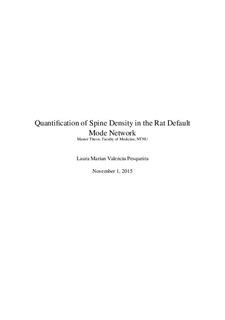| dc.contributor.author | Valencia Pesqueira, Laura Marian | |
| dc.date.accessioned | 2017-10-09T10:33:04Z | |
| dc.date.available | 2017-10-09T10:33:04Z | |
| dc.date.issued | 2015 | |
| dc.identifier.uri | http://hdl.handle.net/11250/2459142 | |
| dc.description.abstract | Using 3D reconstruction of dendrite segments of Golgi-stained neurons in the rat brain, spine density was quantified in different cortical regions of the default mode network. Segments of basal dendrites in layer V pyramidal neurons were sampled. Multiple comparisons pointed to the cingulate cortex with the highest spine density. Previously, fMRI studies have shown that the cingulate cortex has dense connectivity levels with different brain systems, suggesting that the cingulate cortex may act as a transmodal cortical region. The cingulate cortex is one of the functional hubs of the default mode network. Mind wandering is an event of internally directed cognition that drifts freely through diverse thought contents, correlated with activity in the default mode network. Mind wandering has been hypothesized to have a role in cognitive processes that require highly integrated contents and the ability to change and adapt, such as self-regulation and social behavior. The current study provides evidence for the structural support of the high connectivity (i.e. integration capacity) in the cingulate cortex. | nb_NO |
| dc.language.iso | eng | nb_NO |
| dc.publisher | NTNU | nb_NO |
| dc.subject | Neuroscience | nb_NO |
| dc.title | Quantification of Spine Density in the Rat Default Mode Network | nb_NO |
| dc.type | Master thesis | nb_NO |
| dc.subject.nsi | VDP::Medical disciplines: 700::Basic medical, dental and veterinary science disciplines: 710 | nb_NO |
